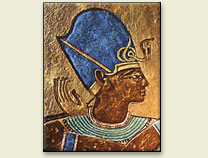King Ramses III. (1170 B.C.) The blue helmet with golden serpent is the symbol of royalty

Blue Hippopotamus, 12th Dynasty (Louvre, Paris)
The blue mineral Lapis Lazuli possessed purportedly life-giving powers. The Book of the Dead describes Horus, the hawk-like son of the God Osiris destroying all evil. After his deed he appears in the heavenly firmament in the form of a hawk and "his torso is made of blue stone". Egyptian Blue (blue frit) was used in conjunction with lapis lazuli for painting eyes, hair and crowns of the pharaos’ statues and sarcophags. Nile, the most important river of ancient Egypt, is rendered in blue color on grave paintings. Blue colored hippopotamuses produced by artisans were popular as symbols for the life-giving river. Nude female figures coated with blue glaze found in egyptian graves might have represented life and Creation.
Intensely blue images of Heaven carrying yellow stars shine from the ceilings of egyptian temples. Blue is the color of the Universe, of the movement of the Sun and the Stars in the firmament merging into the Ocean at the edges of the painting. Blue is also the background color of the paintings depicting the royal graves in the Valley of the Kings. Head kerchiefs of the Kings and their insignia are painted in blue and gold. Jewelry of Tutankhamen was made of gold and lapis lazuli. Pharaos were considered sons of the Sun-God Ra, the highest deity of the Egyptians, who ’s color was gold. Gold as well as blue were both divine colors and the famous mask of Tutankhamen was made of 22 carat gold.
Egyptians saw Life in the deep blue color of water and the Divine in the immense blue of the sky, thus the dawn of the symbolism of the color blue lies in Ancient Egypt (see Egyptian Hymn of the Sun). The color blue, however, precedes all Empires: Skies and Oceans were blue before the dawn of Man on Earth. The cause of the blue color of the sky is dispersion of white light on molecules of air (Ralyleigh scattering), the dispersion being strongly dependent on the wavelength of light ( shorter wavelength of blue light are dispersed the strongest). The first color consciously perceived by Man in Stone Age was, however, not blue but red. It is conceivable that the ability to discern blue and green from other colors was not developed until much later stages of the human history.
(main blues page) - Azurite - cobalt blue - Egyptian blue - Indigo - Prussian blue - smalt - Ultramarine - Cerulean Blue

